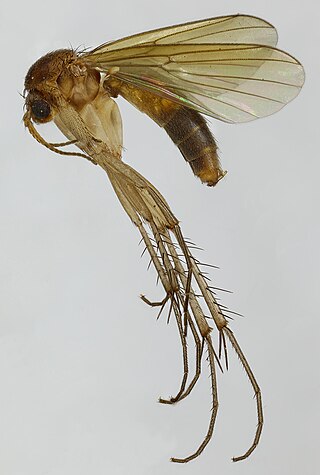
Fire-coloured beetles is the common name for members of the tenebrionoid family Pyrochroidae. The family is found worldwide, and is most diverse at temperate latitudes. Adults measure 2–20 millimetres (0.079–0.787 in); larvae reach 35 millimetres (1.4 in). Larvae of Pyrochroinae are found associated with the bark of dead trees. They are probably mostly fungivorous, although they may become cannibalistic if too crowded.

Lactarius deterrimus, also known as false saffron milkcap or orange milkcap, is a species of fungus in the family Russulaceae. The fungus produces medium-sized fruit bodies (mushrooms) with orangish caps up to 12 centimetres wide that develop green spots in old age or if injured. Its orange-coloured latex stains maroon within 30 minutes. Lactarius deterrimus is a mycorrhizal fungus that associates with Norway spruce and bearberry. The species is distributed in Europe, but has also found in parts of Asia. A visually similar species in the United States and Mexico is not closely related to the European species. Fruit bodies appear between late June and November, usually in spruce forests. Although the fungus is edible—like all Lactarius mushrooms from the section Deliciosi—its taste is often bitter, and it is not highly valued. The fruit bodies are used as source of food for the larvae of several insect species. Lactarius deterrimus can be distinguished from similar Lactarius species by difference in the mycorrhizal host or latex colour.

Mycetophilidae is a family of small flies, forming the bulk of those species known as fungus gnats. About 3000 described species are placed in 150 genera, but the true number of species is undoubtedly much higher. They are generally found in the damp habitats favoured by their host fungi and sometimes form dense swarms.

Hypagyrtis unipunctata, the one-spotted variant moth or white spot, is a moth of the family Geometridae. The species was first described by Adrian Hardy Haworth in 1809. It can be found from Nova Scotia to Florida, west to Texas, northwest to British Columbia on the North American continent, and is also found in Eurasia.
Citrinophila unipunctata is a butterfly in the family Lycaenidae. It is found in the Republic of the Congo, the Democratic Republic of the Congo, Uganda, and possibly north-western Tanzania.
Sparganopseustis unipunctata is a species of moth of the family Tortricidae. It is found in Guatemala.
Testudinaria is a genus of orb-weaver spiders first described by Władysław Taczanowski in 1879.
Sybra unipunctata is a species of beetle in the family Cerambycidae. It was described by Breuning in 1939.

Parastagmatoptera unipunctata is a species of praying mantis in the family Mantidae.

Mycetophila edwardsi is a Palearctic species of 'fungus gnat' in the family Mycetophilidae. Mycetophila edwardsi is found in forest or wooded areas where the larvae develop in fruiting bodies of large fungi.

Mycetophila fungorum is a Palearctic species of 'fungus gnats' in the family Mycetophilidae. Mycetophila fungorum is found in forest or wooded areas where the larvae develop in Agaricales and also obtained with emergence traps over dead wood, soil and ground flora.

Mycetophila luctuosa is a Palearctic species of 'fungus gnats' in the family Mycetophilidae. Mycetophila luctuosa is found in forest or wooded areas where the larvae develop in Neolentinus lepideus, Kretzschmaria deusta, Chondrostereum purpureum, Sebacina incrustans, Neolentinus tigrinus, Pleurotus spp., Trametes versicolor and a wide range of epigeic fungi, mostly Russulaceae.

Mycetophilini is a tribe of fungus gnats in the family Mycetophilidae. There are about 8 genera and at least 220 described species in Mycetophilini.

Mycetophilinae is a subfamily of fungus gnats in the family Mycetophilidae. There are more than 30 genera and 2,000 described species in Mycetophilinae. There are two tribes, Exechiini and Mycetophilini.
Abas unipunctata is a species of achilid planthopper in the family Achilidae. It is the only known species in the genus Abas. The genus and species were described by Ronald Gordon Fennah in 1950. It was described on the basis of a single female collected at Senahú, Alta Verapaz in Guatemala. The genus is distinguished from similar taxa in the tribe Plectoderini by the shape of the edges of the frons and pronotal disk.

Mycetophila is a genus of fungus gnats in the family Mycetophilidae. There are at least 740 described species in Mycetophila.
Mycetophila sigmoides is a species of fungus gnats in the family Mycetophilidae.

Physonota unipunctata, known generally as horsemint tortoise beetle, is a species of leaf beetle in the family Chrysomelidae. Other common names include the beebalm tortoise beetle, bergamot tortoise beetle, and one-spotted tortoise beetle. It is found in North America.
Cephalonomia is a genus of parasitoid wasps in the family Bethylidae. There are more than 20 described species in Cephalonomia.












